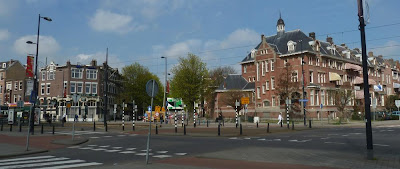Last spring my wife and I walked the Jeneverpad - a well documented walk from Rotterdam to Maasluis, with it's own walking guide. The booklet gives some background information about the places we visit. But more questions are raised during the walk than can be answered. Part 1, part 2, part 2b.
Diergaardesingel - How is it possible that no trace of the Rotterdam zoological garden remains? That only the name of the street "Zoo Canal Street" remembers the ornamental gate, the animal cages and the hat-wearing Victorian gentlemen? In the background one of the ugliest buildings in Rotterdam.
Essenburgsingel - What is the link between luxury quarters form early 1900 and the edge-lands of Dutch cities? Here the edge-land is formed by the railway, in other places by water of the boundary between city and country. Some buildings look like Prague.
G.W. Burgerplein - Are city parks more beautiful because they are surrounded by a wall of housefronts? Because of the extreme contrast? The park is a legacy - the city is not allowed to build there. In the background the house of Pim Fortuyn - the murdered Dutch politician.
Heemraadsingel - A street from the 1900's with notaries and lawyers. Had a bad reputation with drug addicts and other small criminals. It seems the situation is better now. How did poor immigrant workers come to live next to rich urban professionals?
Coolhaven - A strange in-between district. It combines old, new, poor, rich, urban, industrial and maritime elements. Lots of empty and unused space. People live here but it feels like no one lives here. How did that happen?
Delfshaven - An abrupt transition from 1950's architecture to 1600's history. This is where the Pilgrim Fathers left from. What causes this transition? (I saw an article about this in the library today, it is very complicated.)

Hudsonstraat - There used to be a train yard at the left with beautiful vague industry - secondhand car dealers, ceramic tile dealers, carpet-shops. Later prostitution settled here. Now the area has been sanitized. Where have the prostitutes gone now that they are invisible? Now a homeless man and his huge pile of garbage live beneath the wall on the left.
Marconistraat - A fruit-themed artwork in front of the Rotterdam fruit exchange. Fruit exchange? How did that work? What did it do? Why is the building now used as a party center? Do "fruit speculators" still exist and where do they work now?Buitenhavenweg - The impressive and unexpected glass factory. It started as N.V. Glasfabriek "De Schie" in 1897 and was closely linked to the gin factory De Kuyper. Now it's part of Owens-Illinois, Inc., the world’s largest glass container manufacturer.
Buitenhaven - The port was dug in the 15th century. The warehouses might be anything between 16th and 19th century. What is their history? Do they hide Lovecraftian monsters?
Buitenhaven - For maximum contrast these are followed by a supermarket, a standard parking place and an enclosing ring of early 1900 housing. This looks like unused space. Why has nothing been built here yet? Do parking lots raise so much money?
Broersveld - The new shopping arcade. Why do they all look the same? Why do they all contain the sme boring shops? What has happened to local diversity? (It's the economy stupid.)Schiedamsedijk - Taking the streetcar home.
The failure
I think this blog entry is a failure. The walk itself was very interesting and it is higly recommended. The pictures are a good illustration of the variety of cityscapes that one encounters. But it is almost impossible to write anything intelligent about the walk. The walk raises so many questions that all focus is lost. We might summarize it like this:
- The city is an extremely complex system.
- Life is too short to understand it in all details.
- There is no hope for the amateur.
- An amateur must focus on even smaller details. Like Umberto Eco writes in his manual Come si fa una tesi di laurea (1977) it is impossible to write a thesis about "Geology". You have to limit yourself. For example:
- "Volcanology" - is too big a subject
- "The volcanoes of Mexico" - could be used, but it wil be a very shallow study
- "The history of the Popocatepetl" - would be a more interesting study
- "The birth and the seeming extinction of the Parutin volcano 1943 to 1952" - would produce the best study and it could contain all that is known about the volcano in question. This would be Umberto Eco's choice.
References:
Jeneverpad - Wikipedia
Jeneverpad - Booklet














No comments:
Post a Comment